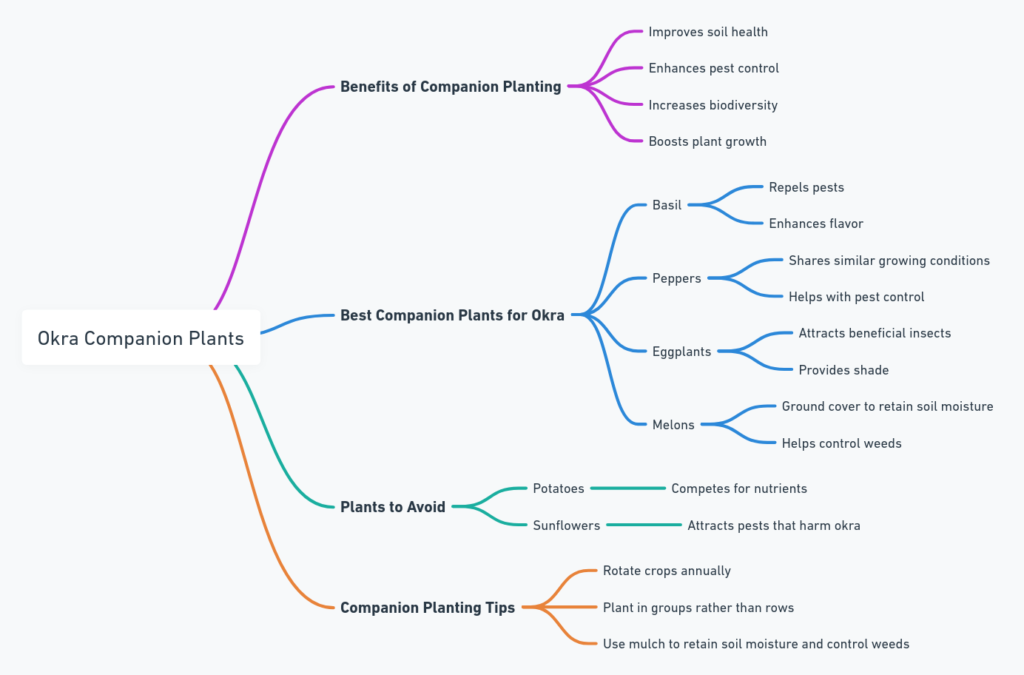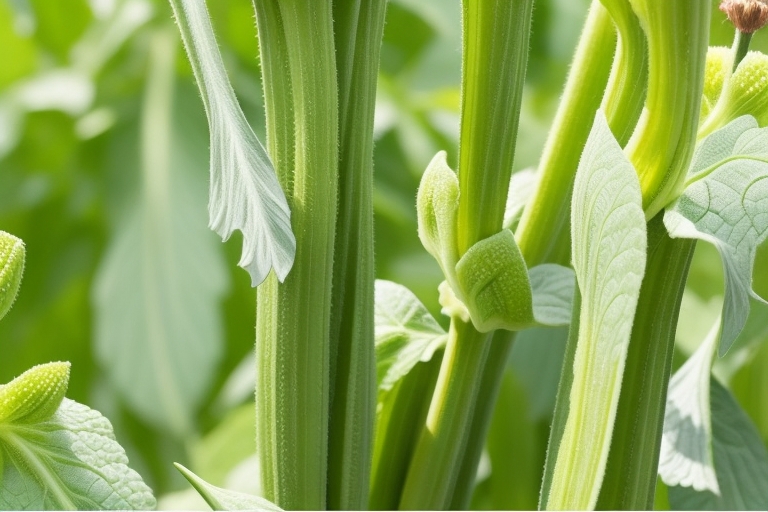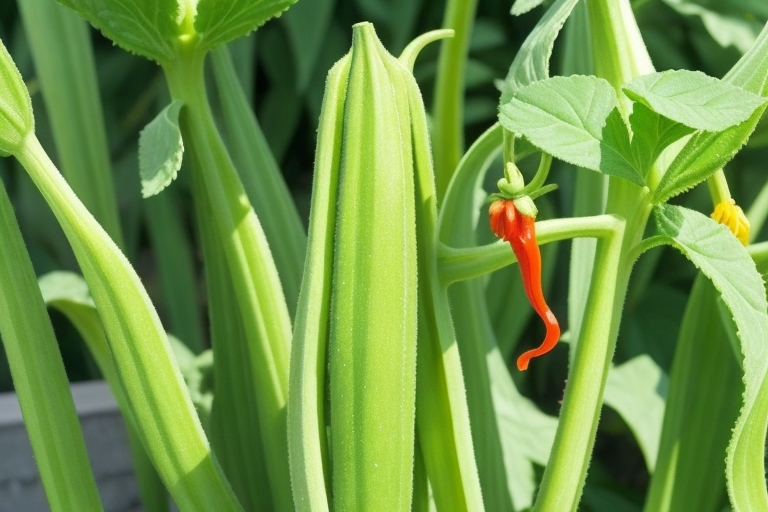Okra, those tender finger-shaped delights, deserve more than just a spot in the garden. By choosing the right Okra Companion Plants, you can unlock a treasure trove of benefits! This post isn’t just about aesthetics; it’s about creating a thriving ecosystem where your okra flourishes. We’ll delve into the world of beneficial partnerships, exploring plants that repel pests, attract pollinators, and even fix essential nutrients in the soil.
Forget the solo act – your okra craves a supporting cast! Discover surprising plant pairings that boost yields, enhance flavor, and create a garden brimming with biodiversity. So, ditch the monoculture and embrace the power of Okra Companion Plants – let’s get growing!

Do Okra Roots Grow Deep?
Understanding the root system of okra plants
Okra plants have a taproot system, meaning they have one large, central root that grows vertically downwards. The taproot anchors the plant and helps access moisture and nutrients deep in the soil. In addition to the taproot, okra plants also grow smaller lateral roots that spread out horizontally near the soil surface.
The depth the taproot reaches depends on the soil conditions. In loose, well-drained soils, okra taproots can penetrate over 3 feet deep. However, growth may be more shallow, around 1-2 feet, in dense or compacted soils where the roots have difficulty pushing through.
How deep do okra roots typically grow?
Typically, okra roots grow 1.5 to 3 feet deep under ideal conditions. The taproot will penetrate deeper in search of moisture during dry periods. Shallow lateral roots will proliferate when adequate moisture is present near the surface.
Sandy loam soils allow for the deepest root penetration, while heavy clay soils restrict depth. Proper soil preparation with organic matter improves drainage and rooting depth. Areas with high water tables also limit how far down okra roots grow.
Factors that can affect the depth of okra roots
The main factors that affect okra root depth include:
- Soil type – Sandy, loamy soils allow for deeper growth than dense clay soils
- Soil compaction – Compacted soils severely limit root penetration
- Drainage – Poor drainage limits depth as roots require oxygen
- Water table level – High water tables restrict vertical root growth
- Nutrient levels – Low nutrients can cause roots to grow longer in search of food
- Weather conditions – Drought causes roots to grow deeper seeking moisture
Taking steps to loosen soil, improve drainage, add organic matter, and provide adequate nutrients and moisture will optimize conditions for a deep okra root system.
Also Read | Swiss Chard Companion Plants
How much Okra can an Okra plant produce?
Factors influencing the yield of okra plants
Several key factors influence the total yield of okra plants:
- Variety – Some varieties are bred for higher productivity
- Planting density – More plants per square foot increases total yield per area
- Soil fertility – Rich, nutrient-dense soils produce higher yields
- Sunlight – Okra needs at least 6 hours of direct sun daily for best production
- Water – Consistent moisture during growth and fruiting optimizes yield
- Pests – Diseases, insects, and animals can reduce yields
- Weather – Extreme or fluctuating temperatures can stress plants
- Pruning – Strategic removal of some fruits redirects energy into remaining pods
Average yield of okra per plant
A single okra plant can produce 1 to 3 pounds of edible pods per season on average. With proper care and favorable conditions, exceptional plants may produce over 5 pounds each. Larger, established plants that grow for the entire season have the highest yields.
For comparison, most okra varieties produce around 8-12 pods per plant. Pods are typically 3-6 inches long and weigh 2-3 ounces each.
Tips for maximizing okra production
To maximize okra yields:
- Choose high-yielding varieties suitable for your climate
- Start with healthy transplants or sow seeds directly in warm soil
- Space plants 12-18 inches apart in fertile, well-drained soil
- Fertilize plants according to soil test recommendations
- Use drip irrigation and mulch to conserve soil moisture
- Control weeds which compete for water and nutrients
- Scout regularly for pests and diseases
- Harvest pods every 2-3 days to encourage more production

Companion Planting: Nature’s Powerful Partnership
Companion planting is a gardening technique where different plants are grown close together to benefit each other. It’s like creating a supportive community in your garden! These partnerships offer a range of advantages:
- Pest Control: Strong-smelling herbs like basil and marigolds can repel harmful insects, creating a natural barrier for your vegetables.
- Pollination Boost: Flowers like alyssum attract pollinators like bees and butterflies, ensuring your food-producing plants get the love they need.
- Nutrient Sharing: Legumes like beans fix nitrogen in the soil, benefiting other plants that need this essential nutrient.
- Vertical Gardening: Taller plants like corn can provide shade for heat-sensitive veggies like lettuce, maximizing space and resources.
- Improved Flavor: Some combinations, like tomatoes and basil, are said to enhance each other’s flavor when grown together.
Getting started with companion planting is easy! Research plant partnerships based on your local climate and desired outcomes. Consider factors like sunlight needs, root depth, and potential pest issues. Remember, it’s not just about pairing “nice” plants together; it’s about creating a balanced and mutually beneficial ecosystem in your garden.
By embracing companion planting, you can:
- Reduce reliance on pesticides
- Increase yields
- Create a more diverse and resilient garden
- Discover the wonders of nature’s collaborations
So, ditch the monoculture and watch your garden thrive with the power of companion planting!
Companion Plants for Okra
Benefits of companion planting with okra
Growing complementary plants alongside okra in the garden has many benefits, including:
- Pest control – Companions like marigolds deter some insect pests
- Enhanced pollination – Flowers of companion plants attract pollinators
- Improved flavor – Some herbs and aromatics enhance taste of okra
- Efficient use of space – Companions optimize vertical and horizontal area
- Soil enrichment – Some plants help fix nitrogen or mine nutrients
- Weed suppression – Low-growing companions shade out weeds
- Crop support – Sturdy neighbors can support climbing okra stems
Best companion plants for okra in traditional garden beds
The best companions to grow with okra in garden beds include:
- Peppers
- Eggplants
- Tomatoes
- Onions/garlic
- Marigolds
- Basil
- Parsley
- Corn
- Beans
- Peas
These plants thrive in hot conditions, don’t compete heavily for space and nutrients, and help repel common okra pests.
Companion plants for okra in container gardening
Good companion plants for growing okra in containers include:
- Petunias
- Marigolds
- Nasturtiums
- Bush beans
- Beets
- Lettuces
- Radishes
- Green onions
- Thyme
- Oregano
These small, fast-growing companions maximize space efficiency in pots while deterring pests, enhancing flavor, and providing additional harvests.
Green Okra Companion Plants
Green vegetables that thrive when planted near okra
Many green leafy vegetables make great companion plants for okra, including:
- Spinach
- Swiss chard
- Kale
- Collards
- Lettuces
- Arugula
- Mustard greens
- Broccoli
- Cabbage
- Green beans
These cool
These cool-weather greens grow well in the partial shade created by okra’s large leaves during the warmer months. They also serve as living mulch to retain soil moisture and control weeds. As an added benefit, the greens repel certain pests like aphids, mites, and flea beetles which may bother the okra plants.
Complementary herbs for green okra varieties
Herbs that enhance the flavor of green, unripe okra pods include:
- Dill
- Parsley
- Cilantro
- Basil
- Oregano
- Thyme
- Rosemary
- Sage
Allowing these herbs to flower near okra attracts beneficial insects for pollination too. Plus, the herbs act as trap crops, luring pests away from the main okra crop.
Creating a harmonious green garden with okra and its companions
By interplanting okra with various leafy greens and herbs, a lush, productive, and pest-resilient green garden can be cultivated. The taller okra provides shade and support for lower-growing companions. Its large leaves mulch the soil, while the extensive root system mines nutrients to share via mycorrhizal networks. The companions, in turn, repel insects, suppress weeds, and enhance flavor. Together, the plant community maximizes yields in a limited space.
This symbiotic system uses vertical space efficiently for high density planting. It requires less external inputs too since the plants largely take care of each other. The diversity also prevents any single pest or disease from devastating the whole garden. A rich, vibrant, edible landscape can be created with okra as the backbone.
Bad companion plants for okra
Plants that may negatively impact okra growth
Some plants make poor companion plants for okra, negatively affecting growth and production. These include:
- Potatoes
- Peppers
- Eggplants
- Tomatoes
- Strawberries
- Raspberries
- Grapes
- Corn
- Cucumbers
- Melons
Many of these species occupy a similar niche as okra. They compete for water, nutrients, sunlight, and space. Their roots also release chemicals that may suppress okra growth.
Common plants to avoid planting near okra
The most problematic companion plants to avoid near okra are:
- Tomatoes
- Peppers
- Eggplants
- Cucumbers
- Melons
Grouped broadly as fruiting vegetables from the gourd family, these species are the fiercest competitors with okra. They stunt okra growth significantly while thriving themselves.
Managing potential issues with incompatible companion plants
If incompatible companions must be grown near okra, the following tactics can help minimize competition:
- Increase spacing between plants
- Use taller trellises or cages for climbing companions
- Use separate drip irrigation lines for each species
- Fertilize more heavily and frequently
- Prune aggressive companions as needed
- Use physical barriers like screening to separate roots
